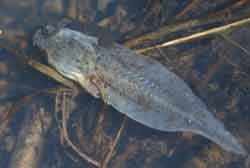 Alberta's WaterIntroductionPublications Climate Change Industrial Impacts Agricultural Impacts Urban Impacts Biodiversity Loss Definitions Links Site Map |
 |
|
 |
| A dead larval Wood Frog |
The field observations clearly suggest that corrosion inhibitors and industrial bactericides in pipelines pose a threat to amphibians and pond ecosystems. Given this evidence, the high rate of failures from an increasingly extensive pipeline network represents a potentially large environmental impact in Alberta. Indeed, the EUB agrees that pipeline failures due to internal corrosion are a large source of liquid releases that pollute the environment. The mechanisms by which these chemicals affect freshwater and terrestrial environments in Alberta are unclear, however. Two potentially toxic compounds in corrosion inhibitors and industrial bactericides are methanol and alkyl-dimethyl ammonium chloride. The latter ingredient belongs to a class of chemicals called quaternary ammonium compounds (QACs) that are registered pesticides and not readily biodegradable.
Recommendations
- Collaborative research between industry and university on the toxicology of pipeline maintenance chemicals
- The oil and gas sector implement new pipeline technology that reduces corrosion, such as the use of internally-coated steel.
Links
- ERSC Environmental News Pipeline Failure Article, written by Cam Stevens
- Cam Steven's Home Page
- Pembina Institute
- The Energy and Utilities Board of Alberta
Acknowledgments
The following organizations provided financial support for the study: Alberta Sport, Recreation, Parks, and Wildlife Foundation (ABSRPWF), Mountain Equipment Co-op (MEC), Natural Sciences and Engineering Research Council (NSERC) of Canada, and Weyerhaeuser Canada, Ltd. Also thanks to the field staff that included Kelly Field, Liam Dunn, and Rayna. This study benefited greatly from the logistical support provided by Drayton Valley division of Weyerhaeuser Canada Ltd., and Randall Lynch with Camp Brazeau, AB.



 Impacts of a Petroleum Pipeline Failure in the Alberta Foothills
Impacts of a Petroleum Pipeline Failure in the Alberta Foothills